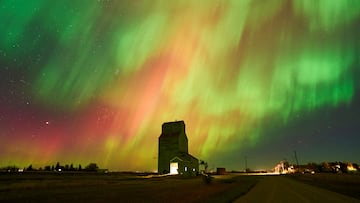Other solar storms that have affected Earth: when, where and what happened?
As another solar storm arrives, with stunning imagery expected, we remember history is littered with their disruptive power.

Solar storms, also known as geomagnetic storms, are disturbances in Earth’s magnetosphere caused by the interaction between the solar wind and the Earth’s magnetic field. The Earth was hit by these conditions in May this year at what is called a G5 (extreme) condition, the first since 2003, impacting on various technologies and systems. At their peak they can include power outages and disrupted communications.
Aside from disruption, the flares are also the producer of the Northern Lights, the aurora borealis.
A large portion of the U.S. will be able to see the northern lights on Thursday night with the naked eye. Of course, this is dependent on cloud cover and light pollution, but due to the electromagnetic solar storm, it should make for a beautiful show. pic.twitter.com/X6GuE5shKH
— Travis Akers (@travisakers) October 9, 2024
Solar storms throughout history
The first recorded solar flare was spotted in 1859. Coincidentally, it is still the most powerful solar storm on record, with auroras seen all over the planet and telegraph communications bursting into flames. Here is a selection of others:
November 1882: A geomagnetic storm caused auroral displays and affected telegraph systems in the US and UK, leading to a switchboard fire in Chicago.
A solar storm is a disturbance on the Sun's surface that releases a burst of energy and particles. This travels outward sometimes impacting Earth's magnetosphere and causing "geomagnetic storms."
— NYC Emergency Management (@nycemergencymgt) October 9, 2024
These storms can disrupt our planet's magnetic field, leading to potential… https://t.co/6pNKapK2lS pic.twitter.com/PUAG24EK4z
October 1903: A significant solar storm during a solar minimum period disrupted communications, causing voltage spikes in telephone lines in Chicago that could “kill a man” and affecting telegraph systems in London.
May 1921: An intense geomagnetic storm, known as the New York Railroad Storm, caused widespread auroras, fires, and severe disruptions to telegraph services in North America and Europe.
January 1938: A massive solar storm lasting 10 days produced auroras across North and Central America, the Caribbean, and Europe, leading to interruptions in transatlantic and North American radio communications.
X1.8 Solar Flare - Big Coronal Mass Ejection of Plasma
— SpaceWeatherNews (@SunWeatherMan) October 9, 2024
Impact to earth is expected Friday/Saturday, with strong geomagnetic storms predicted. pic.twitter.com/4ZQOr0CmRH
August 1972: A solar storm caused widespread disturbances to electrical and communications grids in North America, disrupted satellites, and even caused the accidental detonation of US naval mines near North Vietnam.
March 1989: A geomagnetic storm resulted in communications blackouts, a major power outage in Quebec, Canada, and the loss of positional knowledge for over 1,000 space objects for nearly a week.
October 1989: A series of large radiation storms occurred within one week, forcing astronauts on the International Space Station to shelter in the furthest interior to shield themselves.
July 2000: The Bastille Day Flare caused damage to power systems.
Related stories
Halloween 2003: A series of solar storms caused problems for deep space and near-Earth space missions, rerouting operators and affecting satellite systems and power grids. As mentioned, this was the last G5 strength storm.
Extreme (G5) geomagnetic conditions have been observed! pic.twitter.com/qLsC8GbWus
— NOAA Space Weather Prediction Center (@NWSSWPC) May 10, 2024
May 2024: Earlier this year we had one of the strongest displays of auroras on record in the past 500 years. As NASA said, “This has already proven to be a particularly stormy month for our Sun. During the first full week of May, a barrage of large solar flares and coronal mass ejections (CMEs) launched clouds of charged particles and magnetic fields toward Earth, creating the strongest solar storm to reach Earth in two decades.”